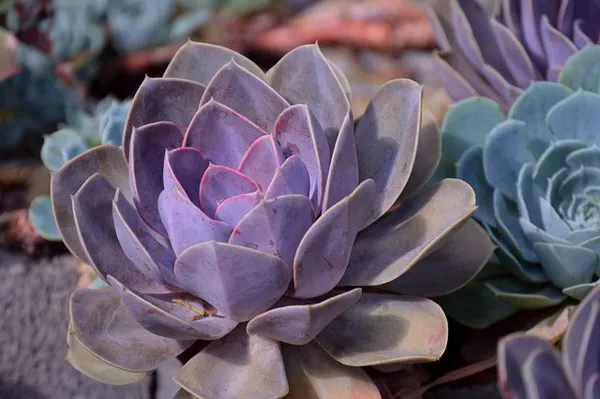Succulents, with their charming and diverse appearances, have become a popular choice among plant enthusiasts and interior decorators alike. These hardy plants are known for their ability to thrive in a variety of conditions, making them an excellent choice for both beginners and experienced gardeners. However, like all plants, succulents have specific requirements that must be met to ensure their health and vitality. In this comprehensive guide, we will explore what succulents need to thrive and offer practical tips for nurturing these delightful plants.
Light Requirements
One of the most critical factors in succulent care is providing the appropriate amount of light. Succulents are native to arid regions, and they have evolved to thrive in bright, direct sunlight. Here’s what you need to know about their light requirements:
Bright Light: Succulents thrive in bright, indirect sunlight. Place them near a south or west-facing window where they can receive several hours of sunlight each day. Inadequate light can lead to leggy, etiolated growth, and eventually, the decline of your succulent.
Avoid Harsh Sunlight: While succulents love sunlight, they can get sunburned if exposed to intense, direct sunlight for extended periods. In such cases, move them to a spot with filtered light or provide shade during the hottest part of the day.
Artificial Light: If natural light is insufficient, consider using grow lights specially designed for succulents. These lights provide the necessary spectrum of light for healthy growth and can be a great solution for indoor succulent gardens.
Watering Succulents
Proper watering is another crucial aspect of succulent care. Overwatering is one of the most common mistakes made by succulent enthusiasts. Here’s how to water your succulents effectively:
Allow Soil to Dry: Succulents are adapted to thrive in dry conditions, so it’s essential to let their soil dry out completely between watering. Check the soil moisture by inserting your finger about an inch into the soil. If it feels dry, it’s time to water.
Water Thoroughly: When you water your succulents, water them thoroughly, ensuring that water reaches the roots. Water the soil around the base of the plant, not directly on the leaves, to prevent rot.
Use a Well-Draining Soil Mix: Plant your succulents in a well-draining soil mix. Succulents do not tolerate sitting in waterlogged soil, as this can lead to root rot. You can purchase a commercial succulent mix or make your own by combining potting soil with perlite or sand for better drainage.
Adjust Watering Frequency: The frequency of watering will depend on factors like the climate, humidity, and the type of succulent. Generally, water your succulents every 2-4 weeks, but always check the soil moisture before watering.
Temperature and Humidity
Succulents are hardy, but they do have specific temperature and humidity preferences:
Temperature: Succulents prefer temperatures between 60°F and 80°F (15°C to 27°C) during the day. They can tolerate cooler temperatures at night, but it’s essential to protect them from frost, which can be fatal.
Humidity: Succulents thrive in low humidity environments, similar to their native habitats. Avoid placing them in areas with high humidity, as this can lead to rot and other fungal issues.
Containers and Potting
Selecting the right container and potting medium is crucial for succulent success:
Pot Selection: Choose pots or containers with drainage holes to prevent water from pooling at the bottom. Terracotta pots are an excellent choice because they allow the soil to breathe and dry out more quickly.
Potting Medium: As mentioned earlier, use a well-draining potting mix. Mixing in perlite or sand can help improve drainage. Ensure that the container is filled with the appropriate potting medium to allow for proper root development.
Fertilizing Succulents
Succulents have modest fertilization needs, and over-fertilizing can be harmful. Here’s how to fertilize succulents correctly:
Use a Balanced Fertilizer: Select a balanced, water-soluble fertilizer with equal NPK (nitrogen, phosphorus, potassium) ratios, such as 10-10-10 or 14-14-14.
Dilute the Fertilizer: Dilute the fertilizer to half or one-quarter of the recommended strength. Apply it during the active growing season, typically in spring and summer, every 4-6 weeks.
Avoid Fertilizing in Winter: Reduce or cease fertilization during the dormant winter months when succulents require less nutrients.
Pest and Disease Management
Succulents are generally pest-resistant, but they can occasionally fall victim to common plant pests such as mealybugs and aphids. Here are some tips for managing pests and diseases:
Inspect Regularly: Regularly inspect your succulents for signs of pests or disease, such as discolored or damaged leaves.
Isolate Affected Plants: If you notice an infestation or disease,isolate the affected succulent to prevent it from spreading to others.
Natural Remedies: Try using natural remedies like neem oil or a mixture of water and mild dish soap to control pests. Always follow the instructions carefully.
Repotting
Succulents may outgrow their containers over time, and repotting may become necessary. Here are some guidelines for when and how to repot succulents:
Repot When Root-Bound: Repot your succulent when you see its roots outgrowing the pot or if it becomes top-heavy and unstable.
Choose a Slightly Larger Pot: Select a new pot that is only slightly larger than the current one to prevent overwatering and encourage healthy root growth.
Allow the Plant to Settle: After repotting, give your succulent a few days to settle into its new container before watering it.
Conclusion
Succulents are undeniably charming and versatile plants, but they do require proper care to thrive. By understanding and providing for their specific needs, such as adequate light, well-draining soil, and proper watering, you can enjoy healthy and vibrant succulents in your home or garden. Remember that each succulent species may have unique care requirements, so it’s essential to research the specific needs of your succulents to ensure their long-term health and beauty. With a little attention and care, you can create a stunning succulent collection that will be the envy of your friends and family.


